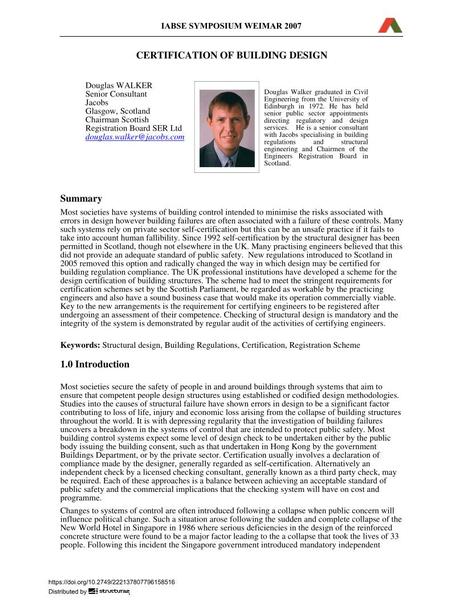Certification of Building Design

|
|
|||||||||||
Détails bibliographiques
| Auteur(s): |
Douglas Walker
|
||||
|---|---|---|---|---|---|
| Médium: | papier de conférence | ||||
| Langue(s): | anglais | ||||
| Conférence: | IABSE Symposium: Improving Infrastructure Worldwide, Weimar, Germany, 19-21 September 2007 | ||||
| Publié dans: | IABSE Symposium Weimar 2007 | ||||
|
|||||
| Page(s): | 428-431 | ||||
| Nombre total de pages (du PDF): | 8 | ||||
| Année: | 2007 | ||||
| DOI: | 10.2749/222137807796158516 | ||||
| Abstrait: |
Most societies have systems of building control intended to minimise the risks associated with errors in design however building failures are often associated with a failure of these controls. Many such systems rely on private sector self-certification but this can be an unsafe practice if it fails to take into account human fallibility. Since 1992 self-certification by the structural designer has been permitted in Scotland, though not elsewhere in the UK. Many practising engineers believed that this did not provide an adequate standard of public safety. New regulations introduced to Scotland in 2005 removed this option and radically changed the way in which design may be certified for building regulation compliance. The UK professional institutions have developed a scheme for the design certification of building structures. The scheme had to meet the stringent requirements for certification schemes set by the Scottish Parliament, be regarded as workable by the practicing engineers and also have a sound business case that would make its operation commercially viable. Key to the new arrangements is the requirement for certifying engineers to be registered after undergoing an assessment of their competence. Checking of structural design is mandatory and the integrity of the system is demonstrated by regular audit of the activities of certifying engineers. |
||||
| Mots-clé: |
certification
|
||||
